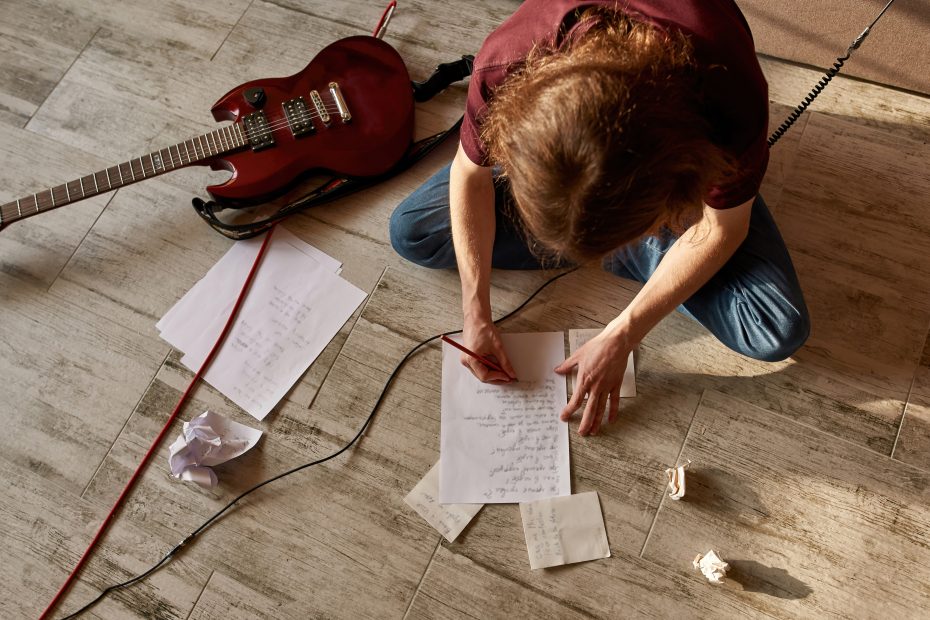Music, an eclectic mix of sounds and silences, is a universal language that bridges gaps, brings people together, and triggers emotions. The craft of songwriting, integral to the creation of these beautiful musical narratives, is a creative journey where “self-expression” and “creativity in music” go hand in hand. Whether you’re an aspiring musician or a seasoned artist, the magic of crafting your “first song” or the hundredth one never fades.
In this article, we delve deep into the songwriting process, walking you through the fundamentals and nuances that shape a song. By the end of this read, we aim to provide you with a comprehensive toolkit that will guide you to bring your musical imagination to life.
Understanding the Basics of Song Structure
Before we set out to write a song, it’s crucial to understand the blueprint that most songs follow, commonly known as the “song structure“. This structure, like the foundation of a building, provides stability and flow to your song.
Elements of a Song
In essence, a song typically consists of “verses,” a “chorus,” and occasionally a “bridge.” The verse sets up the context, the chorus is the hook that carries the main theme or message of the song, and the bridge, when used, provides a contrasting section to keep the song engaging.
Typical Song Structure
A commonly used structure in popular music is Verse-Chorus-Verse-Chorus-Bridge-Chorus. This structure provides a balance between repetition (the chorus) and new content (the verses and bridge) which keeps listeners engaged while also giving them something familiar to latch onto.
Brainstorming Ideas for Your Song
Creativity in songwriting is not solely a spontaneous endeavor; it’s often a result of purposeful brainstorming and exploration of ideas. Here’s a step-by-step guide to help you brainstorm and find “songwriting inspiration.”
Step 1: Decide on a Theme
Songs tell stories or express emotions, so it’s helpful to decide on a main theme or idea for your song. This could be a personal experience, a reaction to an event, or a concept you find interesting.
Step 2: Freewrite
Once you have a theme, start freewriting about it. Don’t worry about rhyming or making sense at this stage; the goal is to get all your thoughts on paper.
Step 3: Find Your Lyrical Hooks
Look through what you’ve written and find any phrases or lines that stand out—these could serve as potential lyrical hooks or chorus lines.
Step 4: Develop Your Song’s Structure
Once you have a few hooks and a general idea of what you want to say, start developing your song’s structure. Place your hooks where you think they fit best and start fleshing out your verses and bridge.
Remember, “musical inspiration” can come from anywhere, so always keep an open mind and heart as you navigate through the process.
10 Essential Tools for Beginner Songwriters
Writing your first song can feel like a daunting task, but thankfully, there are a plethora of “songwriting tools” designed to facilitate the process. Here are 10 essential tools and “songwriting resources” that can prove incredibly useful for “beginner songwriters”:
1. Notebook and Pen:
Perhaps the most traditional and organic tool, a notebook and pen offer the tactile experience of writing that can help spark creativity.
2. Voice Recorder App:
Capture sudden melodic ideas or lyric inspirations on your smartphone’s voice recorder app.
3. Digital Audio Workstations (DAW):
Software like GarageBand, Logic Pro, or Ableton Live can help you record, edit, and produce your song.
4. Virtual Instruments:
DAWs often come with a library of virtual instruments that you can use to compose your melody.
5. Online Rhyming Dictionaries:
Websites like RhymeZone can help when you’re stuck on finding the perfect rhyme.
6. Online Thesaurus:
A thesaurus can help you find just the right word to express what you’re trying to say.
7. Music Theory Books:
Understanding the basics of music theory can help with composing melodies and harmonies.
8. Songwriting Books:
Books like “Writing Music for Hit Songs” by Jai Josefs can provide valuable insights into the craft.
9. MIDI Controller:
This tool can help you compose and record your song in a DAW.
10. Metronome:
A metronome is crucial for maintaining rhythm while composing and recording your song.
The Role of Authenticity in Songwriting
In an era where music production technology can create a near-perfect sound, it’s easy to forget that the real essence of a song lies in its emotional resonance. And that resonance often comes from “authenticity” and “emotional honesty.” These elements can turn a good song into a great one.
“Authentic songwriting” isn’t about perfection. It’s about being true to your experiences, emotions, and perspective. Authentic songs often come from a place of truth, exposing vulnerabilities, and showing a piece of the songwriter’s soul. This genuine “creative expression” not only enhances the depth and relatability of your song but also forms a genuine connection with the audience.
Remember, listeners can sense authenticity and are more likely to be moved by a song that mirrors genuine human experiences and emotions. Strive to be real and truthful in your songwriting, and your music will invariably touch the hearts of your listeners.
Crafting Your Lyrics
Lyrics give your song a voice and narrative. Here’s a guide on “writing lyrics” for your song:
Step 1: Determine the Song’s Theme
A song’s theme is the backbone of its lyrics. Reflect on what you want to convey. It could be a story, an emotion, or a concept.
Step 2: Write Freely
Write your thoughts about the theme freely without worrying about rhyming or rhythm. At this stage, focus on gathering ideas.
Step 3: Structure Your Lyrics
Divide your lyrics into verses, choruses, and perhaps a bridge. Make sure each part aligns with your overall theme and that the chorus captures the song’s main idea.
Step 4: Use Imagery
Evoke your listener’s senses by incorporating vivid imagery and emotive language into your lyrics.
Step 5: Rewrite and Refine
After writing your initial draft, review and revise your lyrics. Make sure every word contributes to the song’s theme and mood.
Remember, “songwriting tips” are guidelines rather than hard rules. Let your creativity and personal style shine through as you pen your lyrics.
Composing Your Melody
The melody, the tuneful aspect of a song, carries the lyrics and conveys emotion. But how does one go about “composing melody”? Here are some steps and “melody writing techniques” to help you get started:
Step 1: Understanding the Basics of Music Theory
While not absolutely necessary, knowing “music theory basics” like scales, keys, and chords can help immensely in composing melodies.
Step 2: Start with a Chord Progression
Begin by selecting a simple chord progression. Play around with it on your instrument of choice until you find a rhythmic pattern that resonates with you.
Step 3: Experiment with Notes
Experiment with notes within the chord progression to create a basic melody. Hum or play around with various combinations until you find a pattern you like.
Step 4: Match the Melody to Your Lyrics
Ensure your melody matches the rhythm of your lyrics. It should also reflect the emotion and tone of the words.
Step 5: Refine Your Melody
Listen to your melody over and over. Refine it by adding embellishments, changing note lengths, and varying pitch or rhythm.
Some FAQs Answered On The Relevant Topic
How do I overcome writer’s block?
Writer’s block can be frustrating. Try changing your environment, seeking inspiration in new experiences, or just taking a break. Sometimes, your brain needs time to process and generate ideas.
How do I know if my song is good?
The best judge of your song is you. If it resonates with you and expresses what you want it to, then it’s good. However, feedback from trusted friends or mentors can also be valuable.
Do I need to know music theory to write a song?
While it’s not a requirement, knowing basic music theory can help with understanding how melodies and harmonies work. It can also provide you with tools to communicate your ideas to other musicians.
In Conclusion, creating music is an immersive and transformative journey of self-discovery, one where the destination is as gratifying as the journey itself. This article has covered key areas in writing your first song, from understanding song structure to brainstorming ideas, from crafting lyrics to composing melodies. It’s crucial to remember that there’s no ‘right’ or ‘wrong’ way to approach songwriting. The magic lies in “creativity in songwriting” and “self-expression.” So, go ahead, harness your feelings, thoughts, and experiences, and pen down your “first song.” Here’s to the beginning of many more to come.

Eric Dalius is The Executive Chairman of MuzicSwipe, a music and content discovery platform designed to maximize artist discovery and optimize fan relationships. In addition, he hosts the weekly podcast “FULLSPEED,” where he interviews innovative entrepreneurs across multiple industries. Eric also established the “Eric Dalius Foundation” to provide four scholarships for US-based students. Connect with him on Twitter, Facebook, LinkedIn, Instagram, and Entrepreneur.com.
